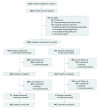Effect of a Breakfast in the Classroom Initiative on Obesity in Urban School-aged Children: A Cluster Randomized Clinical Trial
- PMID: 30801612
- PMCID: PMC6450266
- DOI: 10.1001/jamapediatrics.2018.5531
Effect of a Breakfast in the Classroom Initiative on Obesity in Urban School-aged Children: A Cluster Randomized Clinical Trial
Erratum in
-
Errors in the Abstract, Results Section, and Table 2.JAMA Pediatr. 2019 Jul 1;173(7):704. doi: 10.1001/jamapediatrics.2019.1770. JAMA Pediatr. 2019. PMID: 31135809 Free PMC article. No abstract available.
Abstract
Importance: Serving breakfast in the classroom is promoted to increase participation in the federal School Breakfast Program. However, little is known about the effect of breakfast in the classroom on children's weight status.
Objective: To evaluate the effect of a breakfast in the classroom initiative, which combined breakfast in the classroom with breakfast-specific nutrition education, on overweight and obesity among urban children in low-income communities.
Design, setting, and participants: A cluster-randomized clinical trial among 1362 fourth- through sixth-grade students from low-income urban communities across 2.5 years. Sixteen kindergarten through eighth grade Philadelphia public schools with universal breakfast participated. Participants were recruited in September 2013, and the intervention began in January 2014. Data analysis took place from April 1, 2018, to August 30, 2018.
Interventions: Intervention schools received a program that included breakfast in the classroom and breakfast-specific nutrition education. Control schools continued breakfast before school in the cafeteria and standard nutrition education.
Main outcomes and measures: The primary outcome was the combined incidence of overweight and obesity. Secondary outcomes included the combined prevalence of overweight and obesity, incidence and prevalence of obesity, changes in body mass index (BMI) z score, and School Breakfast Program participation.
Results: Among the 1362 students, mean (SD) age was 10.8 (0.96) years and 700 (51.4%) were female; 907 (66.6%) were black, 233 (17.1%) were Hispanic, 100 (7.3%) were white, 83 (6.1%) were Asian, and 39 were of multiple or other race/ethnicity. After 2.5 years, students in intervention schools had participated in the School Breakfast Program 53.8% of days, compared with 24.9% of days among students in control schools (β = 0.33; 95% CI, 0.22-0.42). There was no difference between intervention and control schools in the combined incidence of overweight and obesity after 2.5 years (11.7% vs 9.3%; odds ratio [OR] 1.31; 95% CI, 0.85-2.02; P = .22). However, the incidence (11.6% vs 4.4%; OR, 2.43; 95% CI, 1.47-4.00) and prevalence (28.0% vs 21.2%; OR, 1.46; 95% CI, 1.11-1.92) of obesity were higher in intervention schools than in control schools after 2.5 years.
Conclusions and relevance: A breakfast in the classroom initiative increased participation in the School Breakfast Program and did not affect the combined incidence of overweight and obesity. However, the initiative had an unintended consequence of increasing incident and prevalent obesity. Further research is needed to identify approaches to increase participation in the School Breakfast Program that do not increase obesity among students.
Trial registration: ClinicalTrials.gov identifier: NCT01924130.
Conflict of interest statement
Figures

Comment in
-
Offering Breakfast in the Classroom and Children's Weight Outcomes.JAMA Pediatr. 2019 Apr 1;173(4):317-318. doi: 10.1001/jamapediatrics.2018.5539. JAMA Pediatr. 2019. PMID: 30801619 No abstract available.
-
Error in Statistical Code in Cluster Randomized Trial on the Effect of a Breakfast in the Classroom Initiative on Obesity in Urban, School-aged Children.JAMA Pediatr. 2019 Jul 1;173(7):703-704. doi: 10.1001/jamapediatrics.2019.1589. JAMA Pediatr. 2019. PMID: 31135871 No abstract available.
Similar articles
-
Breakfast in the Classroom Initiative Does Not Improve Attendance or Standardized Test Scores among Urban Students: A Cluster Randomized Trial.J Acad Nutr Diet. 2022 Jun;122(6):1168-1173.e2. doi: 10.1016/j.jand.2021.12.007. Epub 2021 Dec 16. J Acad Nutr Diet. 2022. PMID: 34923177 Clinical Trial.
-
School Breakfast Policy Is Associated with Dietary Intake of Fourth- and Fifth-Grade Students.J Acad Nutr Diet. 2016 Mar;116(3):449-457. doi: 10.1016/j.jand.2015.08.020. Epub 2015 Oct 1. J Acad Nutr Diet. 2016. PMID: 26433452 Clinical Trial.
-
Implementing School-Based Policies to Prevent Obesity: Cluster Randomized Trial.Am J Prev Med. 2019 Jan;56(1):e1-e11. doi: 10.1016/j.amepre.2018.08.026. Am J Prev Med. 2019. PMID: 30573151 Free PMC article. Clinical Trial.
-
Breakfast and the achievement gap among urban minority youth.J Sch Health. 2011 Oct;81(10):635-40. doi: 10.1111/j.1746-1561.2011.00638.x. J Sch Health. 2011. PMID: 21923876 Review.
-
Is School Gardening Combined with Physical Activity Intervention Effective for Improving Childhood Obesity? A Systematic Review and Meta-Analysis.Nutrients. 2021 Jul 28;13(8):2605. doi: 10.3390/nu13082605. Nutrients. 2021. PMID: 34444765 Free PMC article.
Cited by
-
Interventions to prevent obesity in school-aged children 6-18 years: An update of a Cochrane systematic review and meta-analysis including studies from 2015-2021.EClinicalMedicine. 2022 Oct 19;54:101635. doi: 10.1016/j.eclinm.2022.101635. eCollection 2022 Dec. EClinicalMedicine. 2022. PMID: 36281235 Free PMC article.
-
Treatment of children and adolescents who are overweight or obese.Curr Probl Pediatr Adolesc Health Care. 2020 Sep;50(9):100871. doi: 10.1016/j.cppeds.2020.100871. Epub 2020 Oct 21. Curr Probl Pediatr Adolesc Health Care. 2020. PMID: 33097417 Free PMC article. Review. No abstract available.
-
Obesity, overweight and hyperglycemia among primary school children in a low-middle income country with a multiethnic population.Obes Pillars. 2022 Dec 23;5:100053. doi: 10.1016/j.obpill.2022.100053. eCollection 2023 Mar. Obes Pillars. 2022. PMID: 37990748 Free PMC article.
-
Breakfast Consumption in Low-Income Hispanic Elementary School-Aged Children: Associations with Anthropometric, Metabolic, and Dietary Parameters.Nutrients. 2020 Jul 9;12(7):2038. doi: 10.3390/nu12072038. Nutrients. 2020. PMID: 32659982 Free PMC article.
-
Errors in the Abstract, Results Section, and Table 2.JAMA Pediatr. 2019 Jul 1;173(7):704. doi: 10.1001/jamapediatrics.2019.1770. JAMA Pediatr. 2019. PMID: 31135809 Free PMC article. No abstract available.
References
-
- School Breakfast Scorecard School Year 2016-2017. Washington, DC: Food Research & Action Center; 2018.
-
- Bernstein LS, McLaughlin JE, Crepinsek MK, Daft LM. Evaluation of the School Breakfast Program Pilot Project: Final Report. Washington, DC: US Dept of Agriculture Food & Nutrition Service; 2004.
Publication types
MeSH terms
Associated data
LinkOut - more resources
Full Text Sources
Medical
Miscellaneous

